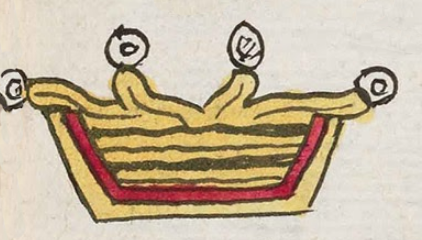apantli (Mdz39r)
This apantli element (logogram) cannot be carved easily from the compound sign for the place name, Acocozpan. But, we include it here independently to representing the noun apantli, water channel or canal, which is an important element in the construction of the compound glyph. It has most of the hallmarks of a typical apantli, except the color of the water is yellow (significant in the place name that the original, compound glyph was trying to convey). The canal is shown in a cross-section view, and it has a trapezoidal shape that is more suggestive of construction than a natural shape. The water has wavy horizontal lines, some of them thick and black, and white water droplets/beads and white turbinate shells splash off the top of the water. The channel has an encasement (a red layer closest to the water, and an outer yellow layer).
Stephanie Wood
The red and yellow colors that separate the water from the earth would seem to be significant. Note our essay on the left relating to red and yellow in the iconography of the hill (tepetl) and shoulder (acolli), for example. The lining of canals can vary in the colors and number of layers, as shown in other examples, below.
Stephanie Wood
c. 1541, but by 1553 at the latest
Stephanie Wood
channels, canals, water

apan(tli), water channel or canal, https://nahuatl.wired-humanities.org/content/apantli
pan(tli), furrow, https://nahuatl.wired-humanities.org/content/pantli
-apan (locative suffix), on the water, https://nahuatl.wired-humanities.org/content/apan-0
a(tl), water, https://nahuatl.wired-humanities.org/content/atl
-pan (locative suffix), on, https://nahuatl.wired-humanities.org/content/pan
coztic, yellow, https://nahuatl.wired-humanities.org/content/coztic
el canal, o en la orilla del agua
Stephanie Wood
Codex Mendoza, folio 39 recto, https://digital.bodleian.ox.ac.uk/objects/2fea788e-2aa2-4f08-b6d9-648c00..., image 88 of 188.
The Bodleian Libraries, University of Oxford, hold the original manuscript, the MS. Arch. Selden. A. 1. This image is published here under the UK Creative Commons, “Attribution-NonCommercial-ShareAlike 3.0 License” (CC-BY-NC-SA 3.0).






